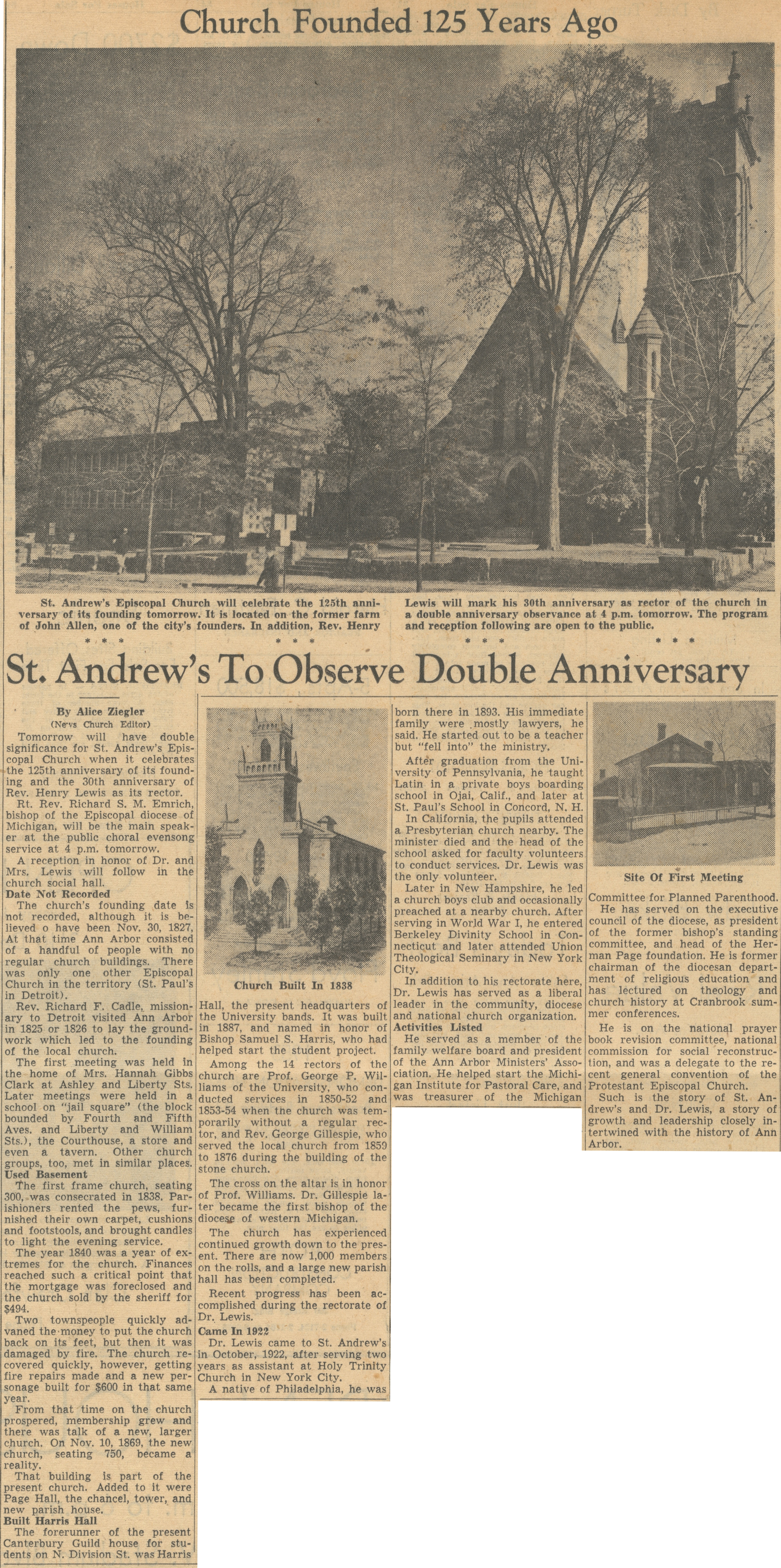St. Andrew's To Observe Double Anniversary

Church Founded 125 Years Ago
St. Andrew's Episcopal Church will celebrate the 125th anniversary of its founding tomorrow. It is located on the former farm of John Allen, one of the city's founders. In addition, Rev. Henry Lewis will mark his 30th anniversary as rector of the church in a double anniversary observance at 4 p.m. tomorrow. The program and reception following are open to the public.
St. Andrew’s To Observe Double Anniversary
By Alice Ziegler (News Church Editor)
Tomorrow will have double significance for St. Andrew's Episcopal Church when it celebrates the 125th anniversary of its founding and the 30th anniversary of Rev. Henry Lewis as its rector.
Rt. Rev. Richard S. M. Emrich, bishop of the Episcopal diocese of Michigan, will be the main speaker at the public choral evensong service at 4 p.m. tomorrow.
A reception in honor of Dr. and Mrs. Lewis will follow in the church social hall.
Date Not Recorded
The church’s founding date is not recorded, although it is believed to have been Nov. 30. 1827, At that time Ann Arbor consisted of a handful of people with no regular church buildings. There only one other Episcopal Church in the territory (St. Paul’s in Detroit).
Rev. Richard F. Cadle, missionary to Detroit visited Ann Arbor in 1825 or 1826 to lay the groundwork which led to the founding of the local church.
The first meeting was held in the home of Mrs. Hannah Gibbs Clark at Ashley and Liberty Sts. Later meetings were held in a school on "jail square” (the block bounded by Fourth and Fifth Aves. and Liberty and William Sts.), the Courthouse, a store and a tavern. Other church groups, too, met in similar places.
Used Basement
The first frame church, seating 300, was consecrated in 1838. Parishioners rented the pews, furnished their own carpet, cushions and footstools, and brought candles to light the evening service.
The year 1840 was a year of extremes for the church. Finances reached such a critical point that the mortgage was foreclosed and the church sold by the sheriff for $494.
Two townspeople quickly advanced the money to put the church back on its feet, but then it was damaged by fire. The church recovered quickly, however, getting fire repairs made and a new personage built for $600 in that same year.
From that time on the church prospered, membership grew and there was talk of a new, larger church. On Nov. 10, 1869, the new church, seating 750, became a reality.
That building is part of the present church. Added to it were Page Hall, the chancel, tower, and parish house.
Built Harris Hall
Church Built In 1838
The forerunner of the present Canterbury Guild house for students on N. Division St. was Harris Hall, the present headquarters of the University bands. It was built in 1887, and named in honor of Bishop Samuel S. Harris, who had helped start the student project.
Among the 14 rectors of the church are Prof. George P. Williams of the University, who conducted services in 1850-52 and 1853-54 when the church was temporarily without a regular rector and Rev. George Gillespie, who served the local church from 1859 1876 during the building of the stone church.
The cross on the altar Is in honor of Prof. Williams. Dr. Gillespie later became the first bishop of the diocese of western Michigan.
The church has experienced continued growth down to the present. There are now 1,000 members on the rolls, and a large new parish hall has been completed.
Recent progress has been accomplished during the rectorate of Dr. Lewis.
Came In 1922
Dr. Lewis came to St. Andrew's in October, 1922, after serving two years as assistant at Holy Trinity Church in New York City.
A native of Philadelphia, he was born there in 1893. His immediate family were mostly lawyers, he said. He started out to be a teacher but “fell into” the ministry.
After graduation from the University of Pennsylvania, he taught Latin in a private boys boarding school in Ojai, Calif., and later at St. Paul’s School in Concord, N. H.
In California, the pupils attended a Presbyterian church nearby. The minister died and the head of the school asked for faculty volunteers to conduct services. Dr. Lewis was the only volunteer.
Later in New Hampshire, he led a church boys club and occasionally preached at a nearby church. After serving in World War I, he entered Berkeley Divinity School in Connecticut and later attended Union Theological Seminary in New York City.
In addition to his rectorate here, Dr. Lewis has served as a liberal leader in the community, diocese and national church organization.
Activities Listed
He served as a member of the family welfare board and president of the Ann Arbor Ministers’ Association. He helped start the Michigan Institute for Pastoral Care, and was treasurer of the Michigan
Committee for Planned Parenthood.
He has served on the executive council of the diocese, as president of the former bishop’s standing committee, and head of the Herman Page foundation. He is former chairman of the diocesan department of religious education and has lectured on theology and church history at Cranbrook summer conferences.
He is on the national prayer book revision committee, national commission for social reconstruction, and was a delegate to the recent general convention of the Protestant Episcopal Church.
Such is the story of St. Andrew’s and Dr. Lewis, a story of growth and leadership closely intertwined with the history of Ann Arbor.
Article
Subjects
Alice Ziegler
Washtenaw County League of Planned Parenthood
St. Andrew's Episcopal Church
Local History
Historic Buildings
Fires - Ann Arbor
Civic Leaders
Canterbury House
Anniversaries
Ann Arbor Ministerial Association
Has Photo
Old News
Ann Arbor News
Samuel S. Harris
Richard S. M. Emrich
Richard F. Cadle
Henry Lewis
Hannah Gibbs Clark
Geroge P. Williams
George Gillespie
306 N Division St